Carbohydrates-II
Sakshi Education

Disaccharides:
A disaccharide is a sugar (a carbohydrate) composed of two monosaccharides. The two monosaccharides are bonded via a condensation reaction. This bond can be between the 1-, 4-, or 6-carbon on each component monosaccharide. So, even if both component sugars are the same (e.g., glucose), different bond combinations result in disaccharides with different chemical and physical properties. Disaccharides can be classified as reducing and non-reducing.
Reducing Disaccharides:
Cellobiose (4-O-ß-D-glucopyranosyl-D-glucose) results from the hydrolysis of cellulose by bacteria. Mammals lack the necessary enzymes—cellobiohydrolases and endo-cellulases—to hydrolyze cellulose. Cellobiose constitutes materials such as cotton and paper. Two glucose units are joined C1 to C4 as a b glycoside.
Gentiobiose: (6-O-ß-D-glucopyranosyl-D-glucose) is found in many glycosides such as amygdalin. Two glucose units are joined C1 to C6 as a b glycoside.
Isomaltose: (6-O-a-D-glucopyranosyl-D-glucose) is formed from two glucose monosaccharides. It is often found at the branching points of amylopectin and glycogen.
Lactose: (4-O-ß-D-galactopyranosyl-D-glucose) (milk sugar) is the predominant disaccharide found in milk. Lactose is a disaccharide that consists of ß-D-galactose and ß-D-glucose molecules bonded through a ß1-4 glycosidic linkage.
Every young child has a special enzyme known as lactase that helps digest lactose. As they grow older, many people lose the ability to digest lactose and cannot tolerate milk (lactose intolerance) or milk products. Because human milk has twice as much lactose as milk from cows, young children who develop lactose intolerance while they are being breast-fed are switched to cows' milk or a synthetic formula based on sucrose. Galactosaemia is a condition that results from an inability to process the D-galactose after hydrolysis.
Laminaribiose is a polysaccharide building unit for laminarin (brown algae), pachyman (fungi), paramylon (unicellular algae), and callose. Mannobiose is the unit for the plant polysaccharide mannan.
Xylobiose is the unit found in many polysaccharides such as the xylans that constitute plant cell walls
 Maltose (4-O-a-D-glucopyranosyl-D-glucose) (Malt sugar) results from hydrolysis of starch by enzymes (amylases) in the mammalian digestive tract. Notice that the glycosidic linkage is a and that of the homopolymer cellobiose is a b linkage.
Maltose (4-O-a-D-glucopyranosyl-D-glucose) (Malt sugar) results from hydrolysis of starch by enzymes (amylases) in the mammalian digestive tract. Notice that the glycosidic linkage is a and that of the homopolymer cellobiose is a b linkage.
It is also the constituent of the polymer amylose. The production of maltose in germinating cereals, such as barley, is an important part of the brewing process.
Non-Reducing sugars:
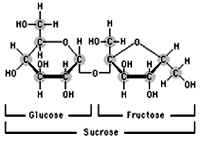 Sucrose (known as table sugar, cane sugar, saccharose, or beet sugar) Sucrose (b-D-fructofuranosyl a-D-glucopyranoside) is the predominant disaccharide found in sugar cane and sugar beet. The linkage is either glu (a-1«2b) Fru or Fru (b2«1a) Glu
Sucrose (known as table sugar, cane sugar, saccharose, or beet sugar) Sucrose (b-D-fructofuranosyl a-D-glucopyranoside) is the predominant disaccharide found in sugar cane and sugar beet. The linkage is either glu (a-1«2b) Fru or Fru (b2«1a) Glu
It is a well-known sweetener and has a five-membered furanosyl unit. 108 tons of sucrose is produced annually for consumption. The specific rotations of sucrose solution are +66.50. During hydrolysis the rotation changes to –19.50. It is also referred to as “invert sugar”. Sucrose is a major intermediate product of photosynthesis. In many plants it is the principal form in which sugar is transported from the leaves to the other parts of the plant body.
 Trehalose (a-D-glucopyranosyl a-D-glucopyranoside) is found in microbes, fungi, and certain insects. One isomer is neotrehalose with an a,ß link. Another isomer is isotrehalose which has a ß,ß link. The linkage is Glu(a1«1a)Glu.
Trehalose (a-D-glucopyranosyl a-D-glucopyranoside) is found in microbes, fungi, and certain insects. One isomer is neotrehalose with an a,ß link. Another isomer is isotrehalose which has a ß,ß link. The linkage is Glu(a1«1a)Glu.
It is the major constituent of circulating fluid (hemolymph) of insects in which it serves as an energy storage compound. Trehalose is the major carbohydrate energy storage molecule used by insects for flight.
Oligiosaccharides:
Many oligiosaccharides are not found as isolated molecules. Instead, they may be attached to other biomolecules (glycoconjugates). Glycoconjugates of proteins and various lipids are especially likely. For example, the lipids on the surface of erythrocytes are conjugated with various oligiosaccharides. The oligiosaccharides are involved in cellular recognition and are responsible for the blood group serotype (A, B, AB, and O). a-, b-, and c-cyclodextrins are a class of cyclic oligosaccharides that contain from six to eight monosaccharides.
Raffinose: Raffinose is a complex carbohydrate, a trisaccharide composed of galactose, fructose, and glucose. It can be found in beans, cabbage, brussels sprouts, broccoli, asparagus, other vegetables, and whole grains. Raffinose is a D-galactosylated version of sucrose:a-D-galactopyranosyl-(1?6)-a-D-glucopyranosyl ß-D-fructofuranoside.
Polysaccharides:
Polysaccharides (sometimes called glycans) are relatively complex carbohydrates. They are polymers made up of many monosaccharides joined together by glycosidic linkages. They are therefore very large, often branched, molecules. They tend to be amorphous, insoluble in water, and have no sweet taste. When all the constituent monosaccharides are of the same type they are termed homopolysaccharides; when more than one type of monosaccharide is present they are termed heteropolysaccharides. Examples include storage polysaccharides such as starch and glycogen and structural polysaccharides such as cellulose and chitin.
Starch:
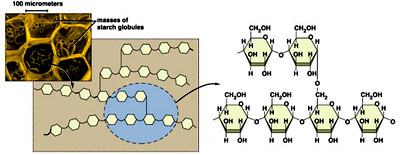 Biochemically, starch is a combination of two polymeric carbohydrates (polysaccharides) called amylose and amylopectin. Amylose is constituted by glucose monomer units joined to one another head-to-tail forming a -1,4 glycosidic bonds (related cellulose has ß-1,4 bonds). Amylopectin differs from amylose in that branching occurs, with an a-1, 6 linkage every 24-30 glucose monomer units. The overall structure of amylopectin is not that of a linear polysaccharide chain since two glucose units frequently form a branch point, so the result is the coiled molecule most suitable for storage in starch grains. Both amylopectin and amylose are polymers of glucose, and a typical starch polymer chain consists of around 2500 glucose molecules in their varied forms of polymerisation.
Biochemically, starch is a combination of two polymeric carbohydrates (polysaccharides) called amylose and amylopectin. Amylose is constituted by glucose monomer units joined to one another head-to-tail forming a -1,4 glycosidic bonds (related cellulose has ß-1,4 bonds). Amylopectin differs from amylose in that branching occurs, with an a-1, 6 linkage every 24-30 glucose monomer units. The overall structure of amylopectin is not that of a linear polysaccharide chain since two glucose units frequently form a branch point, so the result is the coiled molecule most suitable for storage in starch grains. Both amylopectin and amylose are polymers of glucose, and a typical starch polymer chain consists of around 2500 glucose molecules in their varied forms of polymerisation.
Starches are insoluble in water. They can be digested by hydrolysis catalyzed by enzymes called a-amylases, which can break the alpha-linkages. Humans and other animals have amylases, so they can digest starches. Potato, rice, wheat and maize are major sources of starch in the human diet.
Glycogen:
Glycogen is a highly branched polymer of about 30,000 glucose residues and has a molecular weight between 106 and 107 daltons (4.8 million approx.). Most of Glc units are linked by a a-1, 4 glycosidic bonds, approximately 1 in 12 Glc residues also makes -1,6 glycosidic bond with a second Glc which results in the creation of a branch. Glycogen only has one reducing end and a large number of non-reducing ends with a free hydroxyl group at carbon 4. The glycogen granules contain both glycogen and the enzymes of glycogen synthesis (glycogenesis) and degradation (glycogenolysis). The enzymes are nested between the outer branches of the glycogen molecules and act on the non-reducing ends. Therefore, the many non-reducing end-branches of glycogen facilitate its rapid synthesis and breakdown
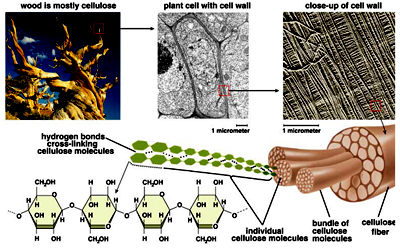 Cellulose: The structural components of plants are formed primarily from cellulose. Wood is largely cellulose and lignin, while paper and cotton are nearly pure cellulose. Cellulose is a polymer made with repeated glucose units bonded together by b-1,4 linkages.
Cellulose: The structural components of plants are formed primarily from cellulose. Wood is largely cellulose and lignin, while paper and cotton are nearly pure cellulose. Cellulose is a polymer made with repeated glucose units bonded together by b-1,4 linkages.
Humans and many other animals lack an enzyme (Cellulases or beta amylases) to break the beta-linkages, so they do not digest cellulose. Certain animals can digest cellulose, because bacteria possessing the enzyme are present in their gut. The classic example is the termite.
Chitin: is one of the main components in the cell walls of fungi, the exoskeletons of insects and other arthropods, and in some other animals.
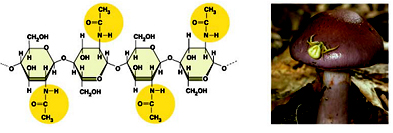 It is a polysaccharide; it is constructed from units of acetylglucosamine (more completely, N-acetyl-D-glucos-2-amine). These are linked together in ß-1, 4 fashion. In effect chitin may be described as cellulose with one hydroxyl group on each monomer replaced by an acetylamine group. This allows for increased hydrogen bonding between adjacent polymers, giving the polymer-increased strength.
It is a polysaccharide; it is constructed from units of acetylglucosamine (more completely, N-acetyl-D-glucos-2-amine). These are linked together in ß-1, 4 fashion. In effect chitin may be described as cellulose with one hydroxyl group on each monomer replaced by an acetylamine group. This allows for increased hydrogen bonding between adjacent polymers, giving the polymer-increased strength.
Glycosaminoglycans (mucopolysaccharides) are polymers of repeating disaccharides. The constituent monosaccharides tend to be modified, with acidic groups, amino groups, sulfated hydroxyl and amino groups, etc. Glycosaminoglycans tend to be negatively charged, because of the prevalence of acidic groups.
Hyaluronate: Hyaluronan (also called hyaluronic acid or hyaluronate) is a glycosaminoglycan distributed widely throughout connective, epithelial, and neural tissues. It is one of the chief components of the extracellular matrix, contributes significantly to cell proliferation and migration, and may also be involved in the progression of some malignant tumors. Hyaluronan is a polymer of disaccharides themselves composed of D-glucuronic acid and D-N-acetylglucosamine, linked together via alternating beta-1,4 and beta-1,3 glycosidic bonds. Polymers of hyaluronan can range in size from 102 to 104 kDa in vivo.
Chondroitin sulfate is a sulfated glycosaminoglycan (GAG) unbranched polysaccharides of variable length containing two alternating monosaccharides: D-glucuronic acid (GlcA) and N-acetyl-D-galactosamine (GalNac). Some GlcA residues are epimerized into L-iduronic acid (IdoA); the resulting disaccharide is then referred to as dermatan sulfate. It is usually found attached to proteins as part of a proteoglycan. A chondroitin chain can have over 100 individual sugars, each of which can be sulfated in variable positions and quantities. Understanding the functions of such diversity in chondroitin sulfate and related glycosaminoglycans is a major goal of glycobiology.
Chondroitin sulfate is a major structural component of cartilage and provides much of its resistance to compression. Along with glucosamine, chondroitin sulfate has become a widely used dietary supplement for treatment of osteoarthritis.
Bacterial Capsule Polysaccharides:
Pathogenic bacteria commonly produce a thick, mucous-like, layer of polysaccharide. This "capsule" cloaks antigenic proteins on the bacterial surface that would otherwise provoke an immune response and thereby lead to the destruction of the bacteria. Capsular polysaccharides are water soluble, commonly acidic, and have molecular weights on the order of 100-1000 kDa.
They are linear and consist of regularly repeating subunits of one ~ six monosaccharides. There is enormous structural diversity; nearly two hundred different polysaccharides are produced by E. coli alone. Mixtures of capsular polysaccharides, either conjugated or native are used as vaccines.
Bacteria and many other microbes, including fungi and algae, often secrete polysaccharides as an evolutionary adaptation to help them adhere to surfaces and to prevent them from drying out. Humans have developed some of these polysaccharides into useful products, including xanthan gum, dextran, gellan gum, and pullulan.
Heparan sulfate is initially synthesized on a membrane-embedded core protein as a polymer of alternating glucuronate and N-acetylglucosamine residues. Later, in segments of the polymer, glucuronate residues may be converted to the sulfated sugar iduronic acid, while N-acetylglucosamine residues may be deacetylated and/or sulfated.
 Heparin, a soluble glycosaminoglycan found in granules of mast cells, has a structure similar to that of heparan sulfates, but is relatively highly sulfated. When released into the blood, it inhibits clot formation by interacting with the protein antithrombin. Heparin has an extended helical conformation. Charge repulsion by the many negatively charged groups may contribute to this conformation. Some cell surface heparan sulfate glycosaminoglycans remain covalently linked to core proteins embedded in the plasma membrane. Proteins involved in signaling and adhesion at the cell surface recognize and bind segments of heparan sulfate chains having particular patterns of sulfation.
Heparin, a soluble glycosaminoglycan found in granules of mast cells, has a structure similar to that of heparan sulfates, but is relatively highly sulfated. When released into the blood, it inhibits clot formation by interacting with the protein antithrombin. Heparin has an extended helical conformation. Charge repulsion by the many negatively charged groups may contribute to this conformation. Some cell surface heparan sulfate glycosaminoglycans remain covalently linked to core proteins embedded in the plasma membrane. Proteins involved in signaling and adhesion at the cell surface recognize and bind segments of heparan sulfate chains having particular patterns of sulfation.
Proteoglycans:
Proteoglycans represent a special class of glycoprotein that are heavily glycosylated. They consist of a core protein with one or more covalently attached glycosaminoglycan chain(s). These glycosaminoglycan (GAG) chains are long, linear carbohydrate polymers that are negatively charged under physiological conditions, due to the occurrence of sulphate and uronic acid groups. Proteoglycans can be categorised depending upon the nature of their glycan chains. These chains may be:
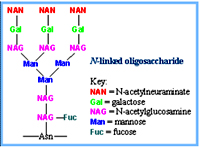 Oligosaccharides of glycoproteins and glycolipids: Oligosaccharides that are covalently attached to proteins or to membrane lipids may be linear or branched chains. They often include modified sugars, e.g., acetylglucosamine, etc.
Oligosaccharides of glycoproteins and glycolipids: Oligosaccharides that are covalently attached to proteins or to membrane lipids may be linear or branched chains. They often include modified sugars, e.g., acetylglucosamine, etc.
O-linked oligosaccharide chains of glycoproteins vary in complexity. They link to a protein via a glycosidic bond between a sugar residue and a serine or threonine hydroxyl. O-linked oligosaccharides have roles in recognition, interaction. N-acetylglucosamine (abbreviated GlcNAc) is a common O-linked glycosylation of protein serine or threonine residues. Many cellular proteins, including enzymes and transcription factors, are regulated by reversible attachment of GlcNAc. Often attachment of GlcNAc to a protein hydroxyl group alternates with phosphorylation, with these two modifications having opposite regulatory effects (stimulation or inhibition).
N-linked oligosaccharides of glycoproteins tend to be complex and branched. Initally N-acetylglucosamine is linked to a protein via the side-chain N of an asparagine residue in a particular 3-amino acid sequence.
Lectins are glycoproteins that recognize and bind to specific oligosaccharides. Concanavalin A and wheat germ agglutinin are plant lectins that have been useful research tools. The C-type lectin-like domain is a Ca++-binding carbohydrate recognition domain present in many animal lectins. Recognition and binding of carbohydrate moieties of glycoproteins, glycolipids, and proteoglycans by animal lectins is a factor in cell-cell recognition, adhesion of cells to the extracellular matrix, interaction of cells with chemokines and growth factors, recognition of disease-causing microorganisms, and initiation and control of inflammation. For example:
Mannan-binding Lectin (MBL) is a glycoprotein found in blood plasma. It binds cell surface carbohydrates of disease-causing microorganisms and promotes phagocytosis of these organisms as part of the immune response.
 Selectins are integral proteins of mammalian cell plasma membranes with roles in cell-cell recognition and binding. The C-type lectin-like domain is at the end of a multi-domain extracellular segment extending outward from the cell surface. A cleavage site just outside the transmembrane a-helix provides a mechanism for regulated release of some lectins from the cell surface. A cytosolic domain participates in regulated interaction with the actin cytoskeleton
Selectins are integral proteins of mammalian cell plasma membranes with roles in cell-cell recognition and binding. The C-type lectin-like domain is at the end of a multi-domain extracellular segment extending outward from the cell surface. A cleavage site just outside the transmembrane a-helix provides a mechanism for regulated release of some lectins from the cell surface. A cytosolic domain participates in regulated interaction with the actin cytoskeleton
Examples of glycoproteins in the immune system are:
Hormones that are glycoproteins include:
The glycocalix is always located on the outer side of the lipid bilayer. The elements of the glycocalix (oligosaccharides) are essential in the process of cell identification and integration, which means they are important components of the receptors. For example, the cell identification during the embryogenesis and the cell growth control depends on the glycocalix.
O-Glycosides
All the di and polysaccharides are O-glycosides. A glycosidic bond may also involve non-saccharide compounds such as phenols. Arbutin is found in the leaves of Rosaceae and, when hydrolyzed, produces hydroquinone. This compound therefore has strong reducing properties that have biochemical consequences.
A disaccharide is a sugar (a carbohydrate) composed of two monosaccharides. The two monosaccharides are bonded via a condensation reaction. This bond can be between the 1-, 4-, or 6-carbon on each component monosaccharide. So, even if both component sugars are the same (e.g., glucose), different bond combinations result in disaccharides with different chemical and physical properties. Disaccharides can be classified as reducing and non-reducing.
Reducing Disaccharides:
Cellobiose (4-O-ß-D-glucopyranosyl-D-glucose) results from the hydrolysis of cellulose by bacteria. Mammals lack the necessary enzymes—cellobiohydrolases and endo-cellulases—to hydrolyze cellulose. Cellobiose constitutes materials such as cotton and paper. Two glucose units are joined C1 to C4 as a b glycoside.
Gentiobiose: (6-O-ß-D-glucopyranosyl-D-glucose) is found in many glycosides such as amygdalin. Two glucose units are joined C1 to C6 as a b glycoside.
Isomaltose: (6-O-a-D-glucopyranosyl-D-glucose) is formed from two glucose monosaccharides. It is often found at the branching points of amylopectin and glycogen.
Lactose: (4-O-ß-D-galactopyranosyl-D-glucose) (milk sugar) is the predominant disaccharide found in milk. Lactose is a disaccharide that consists of ß-D-galactose and ß-D-glucose molecules bonded through a ß1-4 glycosidic linkage.
Every young child has a special enzyme known as lactase that helps digest lactose. As they grow older, many people lose the ability to digest lactose and cannot tolerate milk (lactose intolerance) or milk products. Because human milk has twice as much lactose as milk from cows, young children who develop lactose intolerance while they are being breast-fed are switched to cows' milk or a synthetic formula based on sucrose. Galactosaemia is a condition that results from an inability to process the D-galactose after hydrolysis.
Laminaribiose is a polysaccharide building unit for laminarin (brown algae), pachyman (fungi), paramylon (unicellular algae), and callose. Mannobiose is the unit for the plant polysaccharide mannan.
Xylobiose is the unit found in many polysaccharides such as the xylans that constitute plant cell walls
 Maltose (4-O-a-D-glucopyranosyl-D-glucose) (Malt sugar) results from hydrolysis of starch by enzymes (amylases) in the mammalian digestive tract. Notice that the glycosidic linkage is a and that of the homopolymer cellobiose is a b linkage.
Maltose (4-O-a-D-glucopyranosyl-D-glucose) (Malt sugar) results from hydrolysis of starch by enzymes (amylases) in the mammalian digestive tract. Notice that the glycosidic linkage is a and that of the homopolymer cellobiose is a b linkage. It is also the constituent of the polymer amylose. The production of maltose in germinating cereals, such as barley, is an important part of the brewing process.
Non-Reducing sugars:
 Sucrose (known as table sugar, cane sugar, saccharose, or beet sugar) Sucrose (b-D-fructofuranosyl a-D-glucopyranoside) is the predominant disaccharide found in sugar cane and sugar beet. The linkage is either glu (a-1«2b) Fru or Fru (b2«1a) Glu
Sucrose (known as table sugar, cane sugar, saccharose, or beet sugar) Sucrose (b-D-fructofuranosyl a-D-glucopyranoside) is the predominant disaccharide found in sugar cane and sugar beet. The linkage is either glu (a-1«2b) Fru or Fru (b2«1a) Glu It is a well-known sweetener and has a five-membered furanosyl unit. 108 tons of sucrose is produced annually for consumption. The specific rotations of sucrose solution are +66.50. During hydrolysis the rotation changes to –19.50. It is also referred to as “invert sugar”. Sucrose is a major intermediate product of photosynthesis. In many plants it is the principal form in which sugar is transported from the leaves to the other parts of the plant body.
 Trehalose (a-D-glucopyranosyl a-D-glucopyranoside) is found in microbes, fungi, and certain insects. One isomer is neotrehalose with an a,ß link. Another isomer is isotrehalose which has a ß,ß link. The linkage is Glu(a1«1a)Glu.
Trehalose (a-D-glucopyranosyl a-D-glucopyranoside) is found in microbes, fungi, and certain insects. One isomer is neotrehalose with an a,ß link. Another isomer is isotrehalose which has a ß,ß link. The linkage is Glu(a1«1a)Glu. It is the major constituent of circulating fluid (hemolymph) of insects in which it serves as an energy storage compound. Trehalose is the major carbohydrate energy storage molecule used by insects for flight.
Oligiosaccharides:
Many oligiosaccharides are not found as isolated molecules. Instead, they may be attached to other biomolecules (glycoconjugates). Glycoconjugates of proteins and various lipids are especially likely. For example, the lipids on the surface of erythrocytes are conjugated with various oligiosaccharides. The oligiosaccharides are involved in cellular recognition and are responsible for the blood group serotype (A, B, AB, and O). a-, b-, and c-cyclodextrins are a class of cyclic oligosaccharides that contain from six to eight monosaccharides.
Raffinose: Raffinose is a complex carbohydrate, a trisaccharide composed of galactose, fructose, and glucose. It can be found in beans, cabbage, brussels sprouts, broccoli, asparagus, other vegetables, and whole grains. Raffinose is a D-galactosylated version of sucrose:a-D-galactopyranosyl-(1?6)-a-D-glucopyranosyl ß-D-fructofuranoside.
Polysaccharides:
Polysaccharides (sometimes called glycans) are relatively complex carbohydrates. They are polymers made up of many monosaccharides joined together by glycosidic linkages. They are therefore very large, often branched, molecules. They tend to be amorphous, insoluble in water, and have no sweet taste. When all the constituent monosaccharides are of the same type they are termed homopolysaccharides; when more than one type of monosaccharide is present they are termed heteropolysaccharides. Examples include storage polysaccharides such as starch and glycogen and structural polysaccharides such as cellulose and chitin.
Starch:
 Biochemically, starch is a combination of two polymeric carbohydrates (polysaccharides) called amylose and amylopectin. Amylose is constituted by glucose monomer units joined to one another head-to-tail forming a -1,4 glycosidic bonds (related cellulose has ß-1,4 bonds). Amylopectin differs from amylose in that branching occurs, with an a-1, 6 linkage every 24-30 glucose monomer units. The overall structure of amylopectin is not that of a linear polysaccharide chain since two glucose units frequently form a branch point, so the result is the coiled molecule most suitable for storage in starch grains. Both amylopectin and amylose are polymers of glucose, and a typical starch polymer chain consists of around 2500 glucose molecules in their varied forms of polymerisation.
Biochemically, starch is a combination of two polymeric carbohydrates (polysaccharides) called amylose and amylopectin. Amylose is constituted by glucose monomer units joined to one another head-to-tail forming a -1,4 glycosidic bonds (related cellulose has ß-1,4 bonds). Amylopectin differs from amylose in that branching occurs, with an a-1, 6 linkage every 24-30 glucose monomer units. The overall structure of amylopectin is not that of a linear polysaccharide chain since two glucose units frequently form a branch point, so the result is the coiled molecule most suitable for storage in starch grains. Both amylopectin and amylose are polymers of glucose, and a typical starch polymer chain consists of around 2500 glucose molecules in their varied forms of polymerisation. Starches are insoluble in water. They can be digested by hydrolysis catalyzed by enzymes called a-amylases, which can break the alpha-linkages. Humans and other animals have amylases, so they can digest starches. Potato, rice, wheat and maize are major sources of starch in the human diet.
Glycogen:
Glycogen is a highly branched polymer of about 30,000 glucose residues and has a molecular weight between 106 and 107 daltons (4.8 million approx.). Most of Glc units are linked by a a-1, 4 glycosidic bonds, approximately 1 in 12 Glc residues also makes -1,6 glycosidic bond with a second Glc which results in the creation of a branch. Glycogen only has one reducing end and a large number of non-reducing ends with a free hydroxyl group at carbon 4. The glycogen granules contain both glycogen and the enzymes of glycogen synthesis (glycogenesis) and degradation (glycogenolysis). The enzymes are nested between the outer branches of the glycogen molecules and act on the non-reducing ends. Therefore, the many non-reducing end-branches of glycogen facilitate its rapid synthesis and breakdown
 Cellulose: The structural components of plants are formed primarily from cellulose. Wood is largely cellulose and lignin, while paper and cotton are nearly pure cellulose. Cellulose is a polymer made with repeated glucose units bonded together by b-1,4 linkages.
Cellulose: The structural components of plants are formed primarily from cellulose. Wood is largely cellulose and lignin, while paper and cotton are nearly pure cellulose. Cellulose is a polymer made with repeated glucose units bonded together by b-1,4 linkages. Humans and many other animals lack an enzyme (Cellulases or beta amylases) to break the beta-linkages, so they do not digest cellulose. Certain animals can digest cellulose, because bacteria possessing the enzyme are present in their gut. The classic example is the termite.
Chitin: is one of the main components in the cell walls of fungi, the exoskeletons of insects and other arthropods, and in some other animals.
 It is a polysaccharide; it is constructed from units of acetylglucosamine (more completely, N-acetyl-D-glucos-2-amine). These are linked together in ß-1, 4 fashion. In effect chitin may be described as cellulose with one hydroxyl group on each monomer replaced by an acetylamine group. This allows for increased hydrogen bonding between adjacent polymers, giving the polymer-increased strength.
It is a polysaccharide; it is constructed from units of acetylglucosamine (more completely, N-acetyl-D-glucos-2-amine). These are linked together in ß-1, 4 fashion. In effect chitin may be described as cellulose with one hydroxyl group on each monomer replaced by an acetylamine group. This allows for increased hydrogen bonding between adjacent polymers, giving the polymer-increased strength.Glycosaminoglycans (mucopolysaccharides) are polymers of repeating disaccharides. The constituent monosaccharides tend to be modified, with acidic groups, amino groups, sulfated hydroxyl and amino groups, etc. Glycosaminoglycans tend to be negatively charged, because of the prevalence of acidic groups.
Hyaluronate: Hyaluronan (also called hyaluronic acid or hyaluronate) is a glycosaminoglycan distributed widely throughout connective, epithelial, and neural tissues. It is one of the chief components of the extracellular matrix, contributes significantly to cell proliferation and migration, and may also be involved in the progression of some malignant tumors. Hyaluronan is a polymer of disaccharides themselves composed of D-glucuronic acid and D-N-acetylglucosamine, linked together via alternating beta-1,4 and beta-1,3 glycosidic bonds. Polymers of hyaluronan can range in size from 102 to 104 kDa in vivo.
Chondroitin sulfate is a sulfated glycosaminoglycan (GAG) unbranched polysaccharides of variable length containing two alternating monosaccharides: D-glucuronic acid (GlcA) and N-acetyl-D-galactosamine (GalNac). Some GlcA residues are epimerized into L-iduronic acid (IdoA); the resulting disaccharide is then referred to as dermatan sulfate. It is usually found attached to proteins as part of a proteoglycan. A chondroitin chain can have over 100 individual sugars, each of which can be sulfated in variable positions and quantities. Understanding the functions of such diversity in chondroitin sulfate and related glycosaminoglycans is a major goal of glycobiology.
Chondroitin sulfate is a major structural component of cartilage and provides much of its resistance to compression. Along with glucosamine, chondroitin sulfate has become a widely used dietary supplement for treatment of osteoarthritis.
Bacterial Capsule Polysaccharides:
Pathogenic bacteria commonly produce a thick, mucous-like, layer of polysaccharide. This "capsule" cloaks antigenic proteins on the bacterial surface that would otherwise provoke an immune response and thereby lead to the destruction of the bacteria. Capsular polysaccharides are water soluble, commonly acidic, and have molecular weights on the order of 100-1000 kDa.
They are linear and consist of regularly repeating subunits of one ~ six monosaccharides. There is enormous structural diversity; nearly two hundred different polysaccharides are produced by E. coli alone. Mixtures of capsular polysaccharides, either conjugated or native are used as vaccines.
Bacteria and many other microbes, including fungi and algae, often secrete polysaccharides as an evolutionary adaptation to help them adhere to surfaces and to prevent them from drying out. Humans have developed some of these polysaccharides into useful products, including xanthan gum, dextran, gellan gum, and pullulan.
Heparan sulfate is initially synthesized on a membrane-embedded core protein as a polymer of alternating glucuronate and N-acetylglucosamine residues. Later, in segments of the polymer, glucuronate residues may be converted to the sulfated sugar iduronic acid, while N-acetylglucosamine residues may be deacetylated and/or sulfated.
 Heparin, a soluble glycosaminoglycan found in granules of mast cells, has a structure similar to that of heparan sulfates, but is relatively highly sulfated. When released into the blood, it inhibits clot formation by interacting with the protein antithrombin. Heparin has an extended helical conformation. Charge repulsion by the many negatively charged groups may contribute to this conformation. Some cell surface heparan sulfate glycosaminoglycans remain covalently linked to core proteins embedded in the plasma membrane. Proteins involved in signaling and adhesion at the cell surface recognize and bind segments of heparan sulfate chains having particular patterns of sulfation.
Heparin, a soluble glycosaminoglycan found in granules of mast cells, has a structure similar to that of heparan sulfates, but is relatively highly sulfated. When released into the blood, it inhibits clot formation by interacting with the protein antithrombin. Heparin has an extended helical conformation. Charge repulsion by the many negatively charged groups may contribute to this conformation. Some cell surface heparan sulfate glycosaminoglycans remain covalently linked to core proteins embedded in the plasma membrane. Proteins involved in signaling and adhesion at the cell surface recognize and bind segments of heparan sulfate chains having particular patterns of sulfation.Proteoglycans:
Proteoglycans represent a special class of glycoprotein that are heavily glycosylated. They consist of a core protein with one or more covalently attached glycosaminoglycan chain(s). These glycosaminoglycan (GAG) chains are long, linear carbohydrate polymers that are negatively charged under physiological conditions, due to the occurrence of sulphate and uronic acid groups. Proteoglycans can be categorised depending upon the nature of their glycan chains. These chains may be:
- Chondroitin sulfate and Dermatan sulfate
- Heparin and Heparan sulfate
- Keratan sulfate
 Oligosaccharides of glycoproteins and glycolipids: Oligosaccharides that are covalently attached to proteins or to membrane lipids may be linear or branched chains. They often include modified sugars, e.g., acetylglucosamine, etc.
Oligosaccharides of glycoproteins and glycolipids: Oligosaccharides that are covalently attached to proteins or to membrane lipids may be linear or branched chains. They often include modified sugars, e.g., acetylglucosamine, etc.O-linked oligosaccharide chains of glycoproteins vary in complexity. They link to a protein via a glycosidic bond between a sugar residue and a serine or threonine hydroxyl. O-linked oligosaccharides have roles in recognition, interaction. N-acetylglucosamine (abbreviated GlcNAc) is a common O-linked glycosylation of protein serine or threonine residues. Many cellular proteins, including enzymes and transcription factors, are regulated by reversible attachment of GlcNAc. Often attachment of GlcNAc to a protein hydroxyl group alternates with phosphorylation, with these two modifications having opposite regulatory effects (stimulation or inhibition).
N-linked oligosaccharides of glycoproteins tend to be complex and branched. Initally N-acetylglucosamine is linked to a protein via the side-chain N of an asparagine residue in a particular 3-amino acid sequence.
Lectins are glycoproteins that recognize and bind to specific oligosaccharides. Concanavalin A and wheat germ agglutinin are plant lectins that have been useful research tools. The C-type lectin-like domain is a Ca++-binding carbohydrate recognition domain present in many animal lectins. Recognition and binding of carbohydrate moieties of glycoproteins, glycolipids, and proteoglycans by animal lectins is a factor in cell-cell recognition, adhesion of cells to the extracellular matrix, interaction of cells with chemokines and growth factors, recognition of disease-causing microorganisms, and initiation and control of inflammation. For example:
Mannan-binding Lectin (MBL) is a glycoprotein found in blood plasma. It binds cell surface carbohydrates of disease-causing microorganisms and promotes phagocytosis of these organisms as part of the immune response.
 Selectins are integral proteins of mammalian cell plasma membranes with roles in cell-cell recognition and binding. The C-type lectin-like domain is at the end of a multi-domain extracellular segment extending outward from the cell surface. A cleavage site just outside the transmembrane a-helix provides a mechanism for regulated release of some lectins from the cell surface. A cytosolic domain participates in regulated interaction with the actin cytoskeleton
Selectins are integral proteins of mammalian cell plasma membranes with roles in cell-cell recognition and binding. The C-type lectin-like domain is at the end of a multi-domain extracellular segment extending outward from the cell surface. A cleavage site just outside the transmembrane a-helix provides a mechanism for regulated release of some lectins from the cell surface. A cytosolic domain participates in regulated interaction with the actin cytoskeletonExamples of glycoproteins in the immune system are:
- Molecules such as antibodies (immunoglobulins), which interact directly with antigens
- Molecules of the major histocompatibility complex (or MHC), which are expressed on the surface of cells and interact with T-cells as part of the adaptive immune response.
- Components of the zona pellucida, which surrounds the oocyte, and is important for sperm-egg interaction.
Hormones that are glycoproteins include:
- Follicle stimulating hormone
- Luteinizing hormone
- Thyroid stimulating hormone
- Human chorionic gonadotropin
- Alpha-fetoprotein
- Erythropoietin (EPO)
The glycocalix is always located on the outer side of the lipid bilayer. The elements of the glycocalix (oligosaccharides) are essential in the process of cell identification and integration, which means they are important components of the receptors. For example, the cell identification during the embryogenesis and the cell growth control depends on the glycocalix.
O-Glycosides
All the di and polysaccharides are O-glycosides. A glycosidic bond may also involve non-saccharide compounds such as phenols. Arbutin is found in the leaves of Rosaceae and, when hydrolyzed, produces hydroquinone. This compound therefore has strong reducing properties that have biochemical consequences.
- Amygdalin is isolated as one of the components of the seeds of Rosaceae. Upon enzymatic hydrolysis hydrogen cyanide is evolved. It also has strong biochemical consequences.
- Erythromycin A is a macrolide that has whithin its structure the amino saccharide D-desosamine and the branched saccharide L-cladinose. It inhibits protein synthesis by bactereial ribosomes.
- Streptomycin also intereferes with bacterial peptide synthesis by binding to sites on the ribosomes. It is part of the aminoglycoside family of antibiotics. The saccharide derivatives in streptomycin include the formylpentose L-streptose as well as the rarely seen 2-deoxy-2-methylamino-L-glucose. One of the uses of streptomycin is to treat tuberculosis
- Adriamycin along with the related daunomycin are anthracyclines possessing anti-Gram-positive activity. They also have anticancer properties towards soft-tissue sarcomas and leukaemias. This is probably due to their intercalating behavior towards DNA, which results in the inhibition of RNA and ultimately protein synthesis. L-duanosamine is the saccharide unit found in each.
N-Glycosides
Glycosylamines have important roles in biochemistry since most peptide-carbohydrate linkages are of the N-glycosidic type. These linkages usually involve D-glucosamine bonding to the L-asparagine amido group. D-ribose and 2-deoxy-D-ribose can form N-glycosidic bonds with purine and pyrimidine bases to create nucleotides. This is very significant because nucleotides are components of both DNA and RNA.
- Streptothricin F displays activity against both Gram-negative and Gram-positive bacteria. The aminosaccharide is derived from 2-amino-2-deoxy-D-gulose.
- Lowers blood cholesterol levels and may decrease risk of heart disease
- Maintains bowel regularity
- May decrease risk of colon cancer
- May aid in weight loss
-
Published date : 19 May 2014 03:35PM










